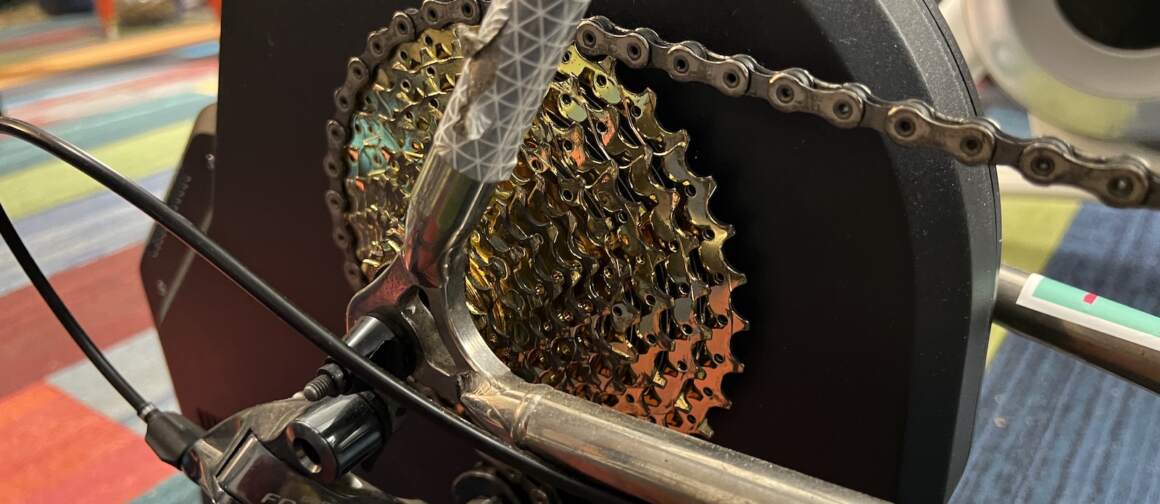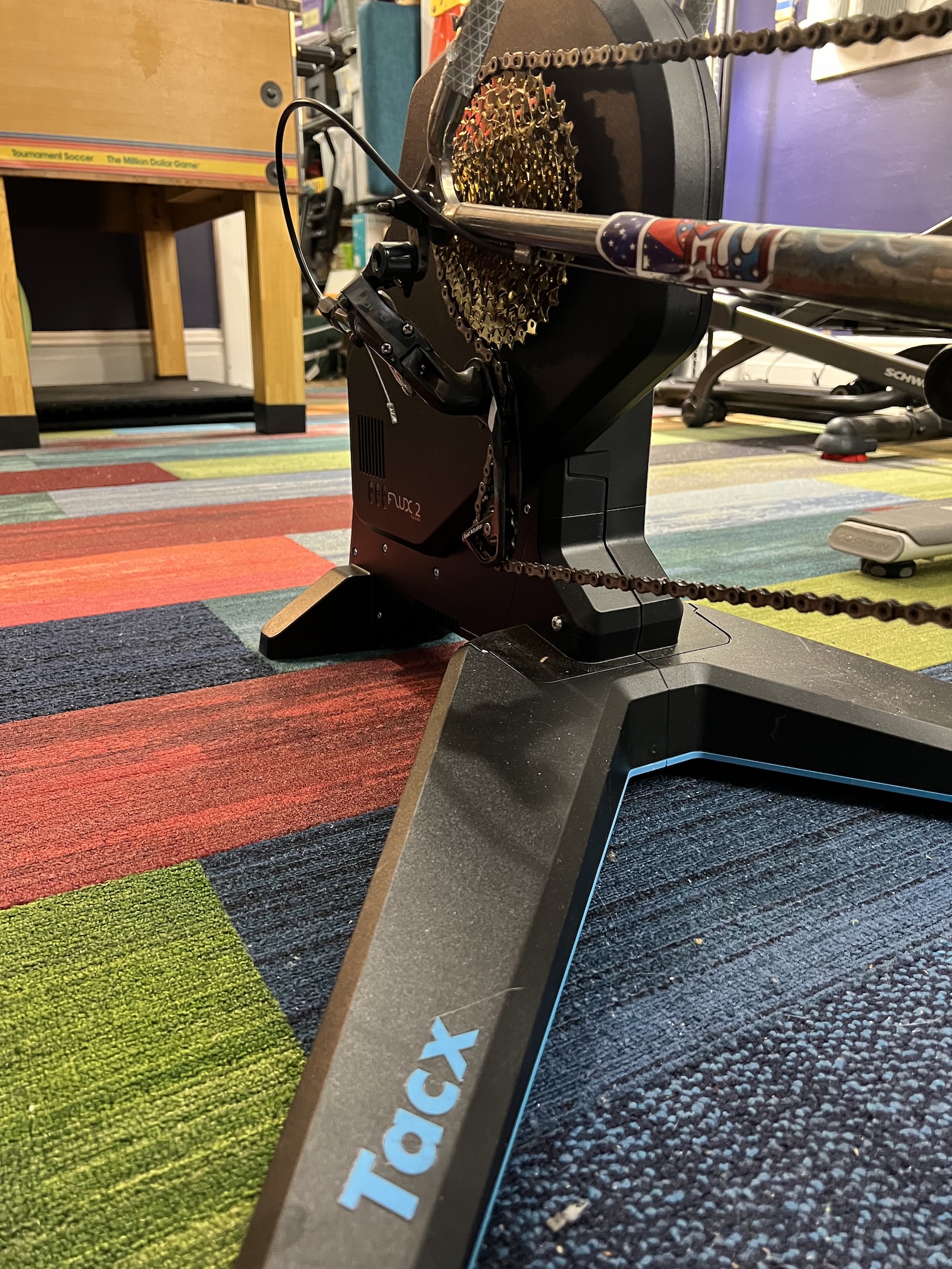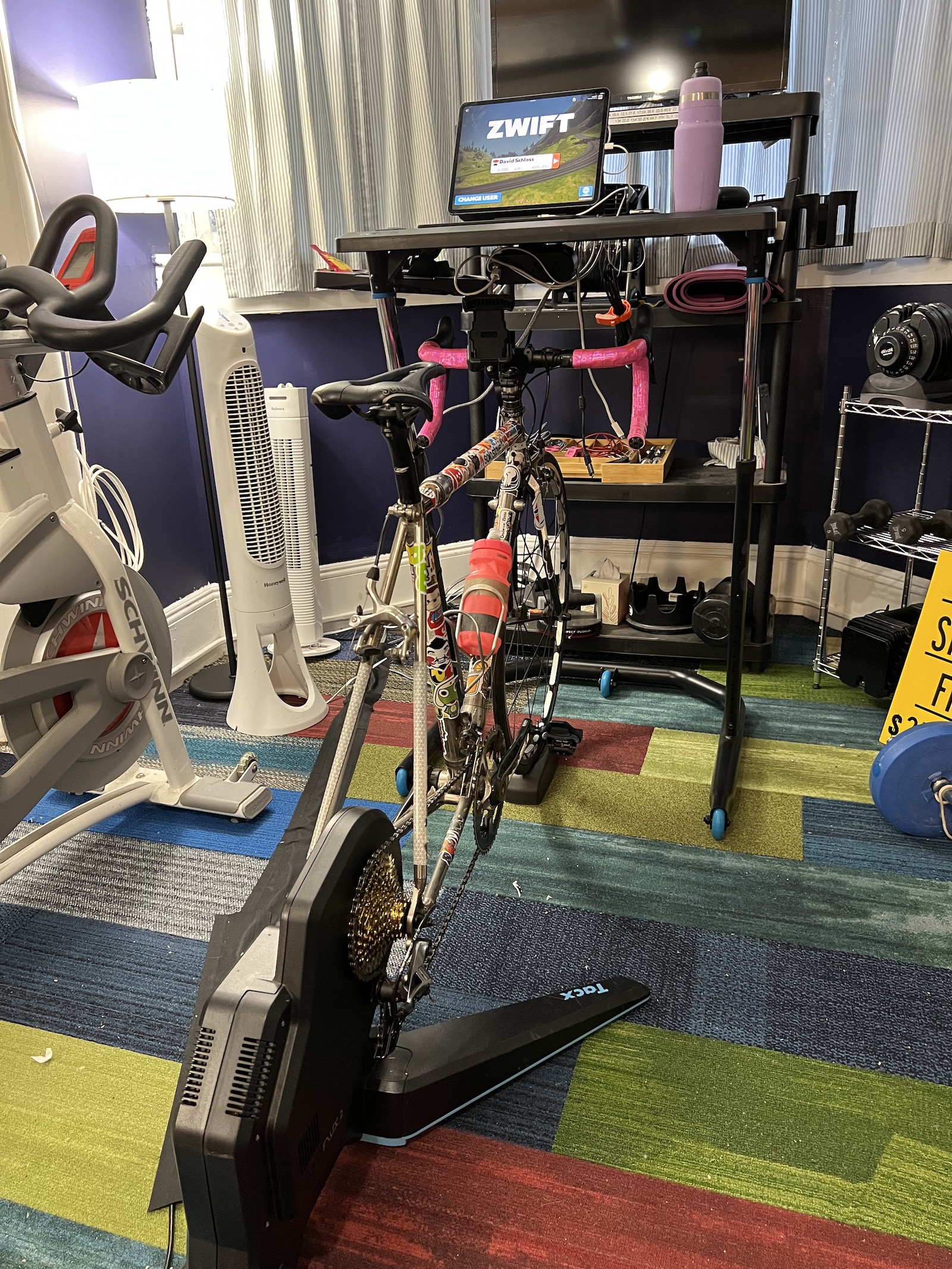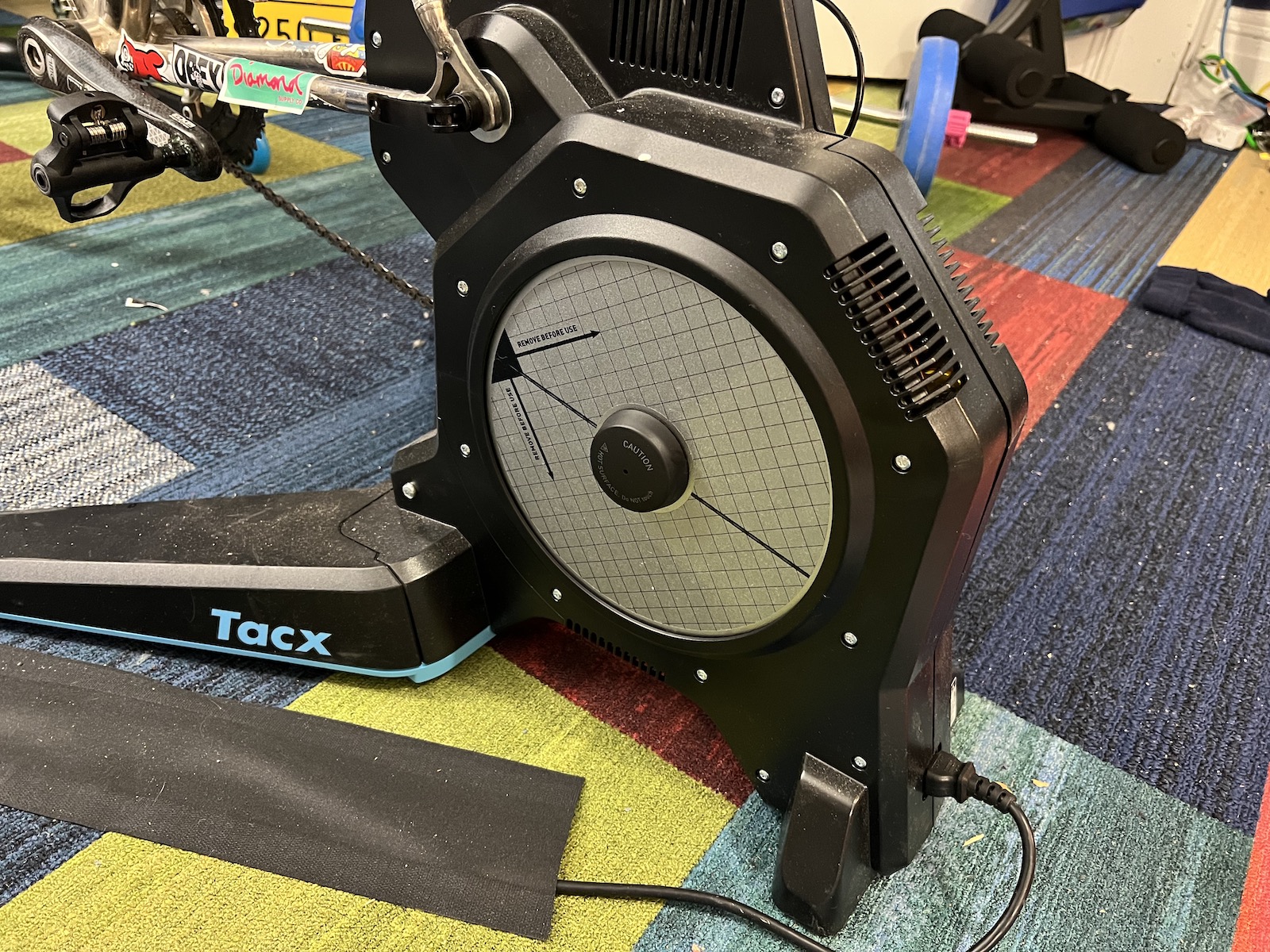
The Garmin Tacx Flux 2 is a smart trainer at an equally smart price.
As winter set upon the Northeast, my opportunities for outdoor cycling quickly dwindled as the forecast started to look more gruesome. Temperatures went from the 30s and 40s during the day to teens and single digits in a week. While I’ve got plenty of cold-weather gear, there’s nothing enjoyable about the cold penetrating my lobster gloves and having my feet numb.

For some, winter is off-season, and it’s a time to balance out those oft-neglected upper body muscles. For many cyclists, winter is the time to switch to indoor riding and maintain or increase the gains made over the last season.
But let’s face it, most indoor riding sucks. Stationary trainers are deadly boring, rollers require too much focus, and spin classes don’t translate to real-world bike conditioning.
There is another option, the “smart trainer.” These interactive trainers provide variable resistance and when paired with a compatible app like Training Peaks, Zwift, Rouvy, BKOOL, or Tacx Training simulate the conditions of an actual bike ride. Also, see our review of the Direto.
Smart trainers simulate climbs and other riding conditions by continually varying the resistance on the rear wheel, enabling users to climb mountains, draft off other racers, and cruise downhill.
Even better, smart trainers send ride data back to the apps, with the most critical bit of data being power (in Watts). All of the training apps use power to determine the speed and also allow them to tailor specific, individual workouts.
Watts is the preferred metric for serious bike training as it’s not affected by gear the way speed or cadence is. If a training plan says you should ride a base mile workout without knowing your power output, there’s no way to tell if you’re overtaxing your body.
With the built-in power meters in a smart trainer, it’s possible to build and follow complex training programs as consistent as those the pros would follow. If you have power meter pedals, this info can also be tracked for a more complex post-ride analysis of individual leg output.

Smart Vs. Dumb
There are two types of smart trainers—wheel drive and direct drive. Wheel drive connects like a standard “dumb” trainer, with the rear wheel hooking into the trainer and the tire sitting on a roller. The second type of trainer is the direct drive trainer, where the rider removes their rear wheel and connects the bike to the trainer with a cassette mounted on the trainer.
Direct drives provide a better experience, as there’s no lost energy in the friction between a wheel and a roller. They eliminate wear on the rear tire and wheel, so you don’t spend your winter wearing out a single tire out of a pair.
Get On The Right Tacx
For this winter’s workouts, I purchased a Garmin Tacx Flux 2, the company’s middle-tier direct-drive trainer. The Flux 2 has a retail price of $899.99 (on Amazon), while the next model up, the Neo 2T, is $1399.99. The Neo 2T allows rocking the bike to the left and right for a more natural training workout. The trainer can also simulate different road conditions like gravel or cobbles, providing the app you’re using supports road simulation.
While the side-to-side motion would have been nice, neither that nor the ability to feel like I’m on cobbles made the $500 difference make sense.
If you’re a hardcore rider looking for the most comfortable and accurate trainer, splurge for the Neo 2T.
Wait, Wasn’t It Just Tacx?
Garmin acquired Tacx to get into the smart trainer market. It brought with them the manufacturing QA that their GPS units are known for. Garmin addressed the existing Tacx issues and has built and/or upgraded a solid line of trainers.
The original Flux 2 had several problems, including measurement (you can read more about that here https://www.dcrainmaker.com/2020/07/tacx-flux-2-smart-trainer-edition-review.html). Garmin quietly replaced it with a newer version in the middle of 2020, less than a year after purchasing Tacx. Since that mid-2020 refresh, the Flux 2 has been rock solid and reliable.
Out Of The Box, On The Bike
The Tacx Flux 2 setup is painless and quick—simply attach the legs to the body of the trainer, then add a cassette, and you’re good to go. All the tools you need are included, as are several different types of adapters for other through-axels.
Since removing my cassette from my current bike was a non-starter, I picked up an inexpensive (and heavy) cassette online with the same gear ratio as my road bike. The weight doesn’t matter since the cassette will never spend a moment in the sun, and the $25 price tag was easy enough to swallow.
Some direct-drive bike trainers come with a cassette. Still, I like the flexibility of swapping out cassettes if I want to attach a different bike with different gear ranges.
The Flux 2 has several adapters for through hubs, but I opted to put one of my older rim brake bikes with standard quick-release skewers on the trainer.
It took less than 20 minutes to go from the box to riding. Having installed cassettes on bikes before reduced some of the build time you might experience if you’re unfamiliar with the process. In any case, one should expect to be riding within half an hour.
As with many smart trainers, the Flux 2 needs AC power, and while the cable they provide is long, it’s not super-long. You’ll want to either be careful with trainer placement or get an extension cord.
While the rear of the trainer is the natural place for an AC cable from a manufacturing standpoint, it’s a bit awkward on a trainer. Most people ride on trainers facing a TV or tablet, both of which need to be plugged in.
Riders often use fans, and those fans need to be plugged in. Since the trainer faces electrical devices, the cord would be more practical in the front. Unless you place your trainer right near a wall with an outlet directly nearby, you will end up with a power cord running across your workout space.
There’s also no power switch on the Flux 2, so if you’d like to turn it off, you’ll need to pull the cord. It’s probably using less juice when it’s not being ridden. The Bluetooth radio is probably off while the device is idle. However, I’m still partial to being able to turn things off manually on the device.
Booting Up
The Flux 2 communicates with devices with Bluetooth or ANT+ (but is controlled via Bluetooth). However, for ANT+ data you’ll need an ANT+ capable device for this functionality (like a Garmin Edge bike computer).
I experienced no Bluetooth connectivity problems with any device and
I also purchased an ANT+ dongle and a USB cable extension for my MacBook Pro. Still, as I haven’t had any drops with Bluetooth, the ANT+ dongle doesn’t actually improve anything. For testing purposes, I can confirm that the Flux 2 and MacBook Pro work well with a cheap ANT+ receiver.
Connecting the Flux 2 to my devices had the usual amount of configuration oddness that any Bluetooth pairing process has.
Having so many devices that connect to the Flux 2 causes the only initial connection issues. I will occasionally have to turn off Bluetooth on one device. At the same time, the one I want to use for my workout connects to the Flux, but then after that, I can flip Bluetooth back on elsewhere.
I found the most problematic use to be when my iPhone was paired with the Tacx to use the Zwift Companion app to communicate to the Flux 2. This simply didn’t work well, so I removed the Flux 2 from my iPhone’s Bluetooth device list, and now I can connect to my iPad, AppleTV, or MacBook Pro with no issues. The iPhone paring issue was more of a problem with the Zwift Companion app than the Flux 2.
Putting It To The Test
I’ve used the Tacx Flux 2 with nearly a dozen cycling apps, and they all work perfectly. I’ve tested it with Zwift, Tacx’s apps, BKOOL, TrainingPeaks, ROUVY, and more. Every single tool works perfectly and seamlessly with the Flux 2.
The only issues I’ve ever had with it are when doing a calibration test in Zwift, where sometimes, after calibration, the watts measurements are way off. On my first trip up Zwift’s Alpes du Zwift after calibrating my trainer, my wattage showed 100 watts during an 11% grade while riding 8 mph (at 180 lbs). If that doesn’t make sense, just know that’s way off.
Today I did a calibration after warming up the trainer for the recommended 10 minutes. The app showed me at 430 watts and 23 mph on the flats while I was barely pedaling.
Zwift tells you to accelerate to 23 mph but at 20 mph instructs the user to stop pedaling. I am guessing that following the instruction to stop instead of finishing hitting 23 mph causes calibration issues. Re-calibrating fixed this, and since it’s only happened in Zwift, I suspect it’s a communication problem.
I have put hundreds of miles and thousands of feet of vertical climbing on the Garmin Tacx Flux 2, and it hasn’t failed me. I spend a lot of time on Reddit forums for Zwift and the other training apps, and I know that some other trainers on the market have problems with strange noises and wobbling. (Since I haven’t tested them personally, I’ll skip calling out the brand as I can’t verify these issues.) These constant complaints about other devices make me happier about buying the Tacx.
Garmin Tacx Flux 2 Yes, It’s Worth Every Penny
It’s tough to write a review for a device that’s so simple at its core and performs without problems. The fact that my biggest issue is the location of the AC power connector should tell you about the value inherent in the design of the Tacx Flux 2.
Having spent a whole winter on it, I wish I had splurged a bit and gotten the higher-end model. That’s not for reliability or performance. It’s simply to gain some horizontal motion when riding long training slogs. There might be an upgrade purchase in the future.
But then again, maybe not. The Garmin Tacx Flux 2 seems built like a tank, and it feels like I could get a good decade of use out of it. It’s a great mid-point between super-expensive and budget-level trainers.
If you’re looking for an upper-middle-level trainer at a reasonable price point with all the specs you need, you could do no better than the Garmin Tacx Flux 2.
We're riding townies, adventure, and mountain bikes. Find recommendations on our store page. As Amazon Associates we earn from qualifying purchases.
